Ask a question from expert
cultural development of gastronomy PDF
76 Pages17739 Words145 Views
Added on 2022-01-17
cultural development of gastronomy PDF
Added on 2022-01-17
BookmarkShareRelated Documents
The cultural development of gastronomy
Culinary art versus future trends
Submitted to
MODUL University Vienna
Promoted by
Eva Aileen Jungwirth-‐Edelmann, MA
Written by
Rita Dahbi
1211056
Vienna, May 2015
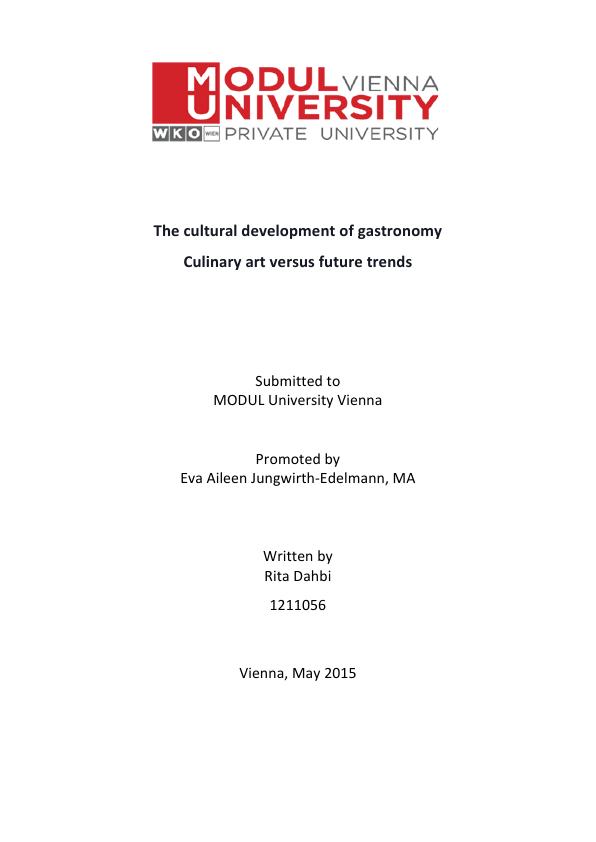
2
Declaration of Academic Honesty
I, Rita Dahbi
Born on the 21. March 1990 in Vienna, Austria
Herewith declare,
1. writing my bachelor thesis autonomously, without the use of sources
and aids, which were not explicitly stated and unauthorized,
2. that I have, neither nationally nor internationally, submitted my bachelor
thesis in any form of examination paper,
3. that all interview partners agreed to the publishing of the interview
content.
Vienna, May 2015 Rita Dahbi
Declaration of Academic Honesty
I, Rita Dahbi
Born on the 21. March 1990 in Vienna, Austria
Herewith declare,
1. writing my bachelor thesis autonomously, without the use of sources
and aids, which were not explicitly stated and unauthorized,
2. that I have, neither nationally nor internationally, submitted my bachelor
thesis in any form of examination paper,
3. that all interview partners agreed to the publishing of the interview
content.
Vienna, May 2015 Rita Dahbi
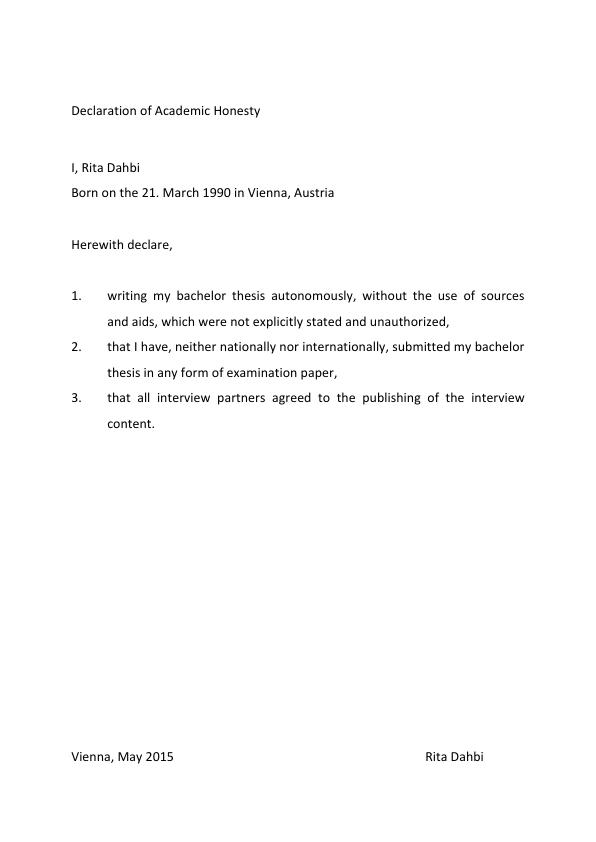
3
Abstract
Topic: The cultural development of gastronomy culinary art versus future trends
Name Author: Rita Dahbi
Course/ Year: BBA in Tourism and Hospitality Management
Pages: 77
Content: The purpose of the thesis is to understand how gastronomy developed
during years, taking into consideration several aspects such as culture and
globalization, which both, had great impact on the industry.
The paper will focus on the gastronomic scene in Vienna with comparisons to
other cities worldwide.
Moreover, this study analyses future trends as well as unique concepts in all forms
and shades.
Furthermore, the research is conducted in such way to gain a deep insight from
the point of view of different experts of the Viennese culinary scene.
The first part of the thesis lays in defining specific words in order to understand
the whole concept of gastronomy. In the second part of the research, we are
looking deeper in the history of culinary art as well as on future trends and
innovation. Last but not least, the third part of this thesis aims to get answers
from experts working in this field.
Supervisor/ Promoter: Eva Aileen Jungwirth-‐Edelmann, MA
Abstract
Topic: The cultural development of gastronomy culinary art versus future trends
Name Author: Rita Dahbi
Course/ Year: BBA in Tourism and Hospitality Management
Pages: 77
Content: The purpose of the thesis is to understand how gastronomy developed
during years, taking into consideration several aspects such as culture and
globalization, which both, had great impact on the industry.
The paper will focus on the gastronomic scene in Vienna with comparisons to
other cities worldwide.
Moreover, this study analyses future trends as well as unique concepts in all forms
and shades.
Furthermore, the research is conducted in such way to gain a deep insight from
the point of view of different experts of the Viennese culinary scene.
The first part of the thesis lays in defining specific words in order to understand
the whole concept of gastronomy. In the second part of the research, we are
looking deeper in the history of culinary art as well as on future trends and
innovation. Last but not least, the third part of this thesis aims to get answers
from experts working in this field.
Supervisor/ Promoter: Eva Aileen Jungwirth-‐Edelmann, MA
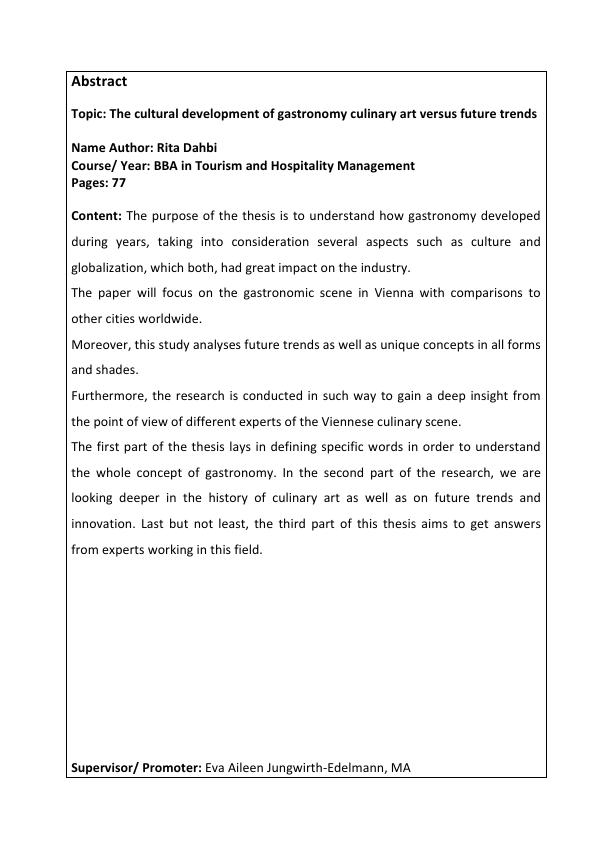
4
Dedication
First and foremost, I want to thank my parents for giving me the possibility to
chase my dreams and for all the love and support I got.
I want to express gratitude to my beloved brother, Idriss, who always believed
in me and strengthen me with positivity throughout my life.
My thanks and appreciation to my supervisor, Eva-‐Aileen Jungwirth-‐Edelmann,
for supporting me as my advisor through out the time it took me to complete
the research and write this thesis.
This thesis is only the beginning of my journey.
Dedication
First and foremost, I want to thank my parents for giving me the possibility to
chase my dreams and for all the love and support I got.
I want to express gratitude to my beloved brother, Idriss, who always believed
in me and strengthen me with positivity throughout my life.
My thanks and appreciation to my supervisor, Eva-‐Aileen Jungwirth-‐Edelmann,
for supporting me as my advisor through out the time it took me to complete
the research and write this thesis.
This thesis is only the beginning of my journey.

5
TABLE OF CONTENT
DECLARATION OF ACADEMIC HONESTY 2
ABSTRACT 3
DEDICATION 4
CHAPTER 1 7
INTRODUCTION 7
MOTIVATION COGNITIVE INTERESTS 7
OUTLINE OF THE RESEARCH QUESTIONS AND ITS LIMITATIONS 9
CHAPTER 2 10
CULTURE 10
2.1 DEFINING CULTURE 10
2.2 DEFINING FOOD CULTURE 12
2.3 AUSTRIAN FOOD CULTURE 13
2.3.1 EXAMPLE OF THE COFFEE HOUSE LEGACY 17
CHAPTER 3 19
GASTRONOMY 19
3.1 DEFINING GASTRONOMY 19
3.2 DEVELOPMENT OF GASTRONOMY 20
3.3 THE FIRST RESTAURANT 22
3.4 FOOD IN TOURISM 24
3.4.1 DEFINING FOOD TOURISM 24
3.5 DEFINING GLOBALIZATION 26
3.6 GLOBALIZATION IN GASTRONOMY 27
3.7 HARD FACTS 27
CHAPTER 4 31
FUTURE TRENDS IN THE FOOD & BEVERAGE INDUSTRY 31
4.1 THE KEY FOR FUTURE COMPETITIVENESS 34
4.2 THE EVOLUTION OF POP UP MARKETS 36
TABLE OF CONTENT
DECLARATION OF ACADEMIC HONESTY 2
ABSTRACT 3
DEDICATION 4
CHAPTER 1 7
INTRODUCTION 7
MOTIVATION COGNITIVE INTERESTS 7
OUTLINE OF THE RESEARCH QUESTIONS AND ITS LIMITATIONS 9
CHAPTER 2 10
CULTURE 10
2.1 DEFINING CULTURE 10
2.2 DEFINING FOOD CULTURE 12
2.3 AUSTRIAN FOOD CULTURE 13
2.3.1 EXAMPLE OF THE COFFEE HOUSE LEGACY 17
CHAPTER 3 19
GASTRONOMY 19
3.1 DEFINING GASTRONOMY 19
3.2 DEVELOPMENT OF GASTRONOMY 20
3.3 THE FIRST RESTAURANT 22
3.4 FOOD IN TOURISM 24
3.4.1 DEFINING FOOD TOURISM 24
3.5 DEFINING GLOBALIZATION 26
3.6 GLOBALIZATION IN GASTRONOMY 27
3.7 HARD FACTS 27
CHAPTER 4 31
FUTURE TRENDS IN THE FOOD & BEVERAGE INDUSTRY 31
4.1 THE KEY FOR FUTURE COMPETITIVENESS 34
4.2 THE EVOLUTION OF POP UP MARKETS 36
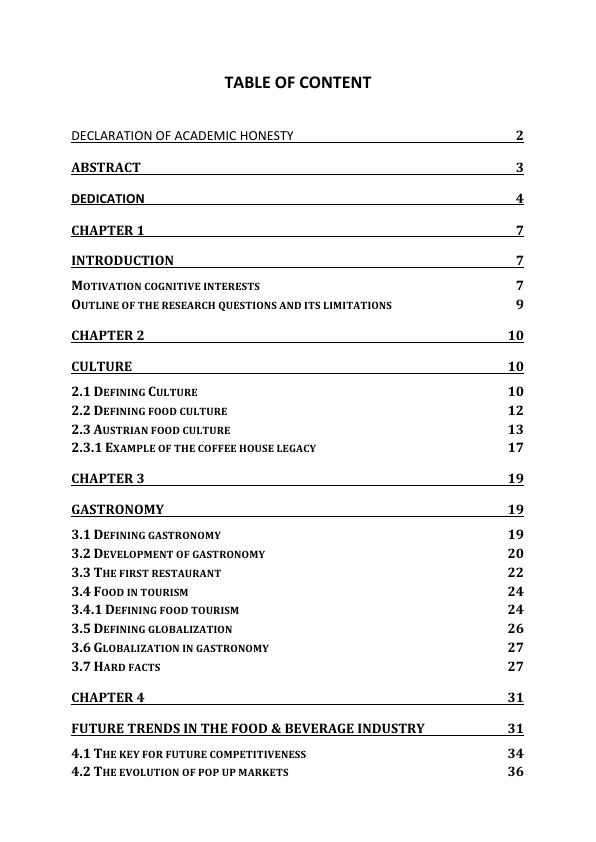
6
4.2.1 EXAMPLES OF POP UP MARKETS 37
4.3 STREET FOOD – NOW AND THEN 38
4.3.1 WHAT IS STREET FOOD? 38
4.3.2 STREET FOOD INTERNATIONAL 38
4.4 VIENNA FOOD WEEK 40
4.5 PRESENTATION OF UNIQUE CONCEPTS 41
TABLE 6: UNIQUE CONCEPTS AROUND THE WORLD SOURCE: 42
CHAPTER 5 43
METHODOLOGY 43
5.1 AIM OF THE INTERVIEW 43
5.2 RESEARCH DESIGN 44
5.3 UNIT OF ANALYSES 44
5.4 PARTICIPANTS 46
5.5 SELECTION CRITERIA 47
5.7 CONSTRUCTION OF INTERVIEWS 48
5.6 REFLECTIONS CONCERNING QUESTIONNAIRE 48
CHAPTER 6 51
EVALUATION AND FINDINGS 51
6.1 INTERVIEW SUMMARY 51
6.2 CONCLUSION OF THE OUTCOME 60
REFLECTION 62
BIBLIOGRAPHY 64
APPENDICES 70
4.2.1 EXAMPLES OF POP UP MARKETS 37
4.3 STREET FOOD – NOW AND THEN 38
4.3.1 WHAT IS STREET FOOD? 38
4.3.2 STREET FOOD INTERNATIONAL 38
4.4 VIENNA FOOD WEEK 40
4.5 PRESENTATION OF UNIQUE CONCEPTS 41
TABLE 6: UNIQUE CONCEPTS AROUND THE WORLD SOURCE: 42
CHAPTER 5 43
METHODOLOGY 43
5.1 AIM OF THE INTERVIEW 43
5.2 RESEARCH DESIGN 44
5.3 UNIT OF ANALYSES 44
5.4 PARTICIPANTS 46
5.5 SELECTION CRITERIA 47
5.7 CONSTRUCTION OF INTERVIEWS 48
5.6 REFLECTIONS CONCERNING QUESTIONNAIRE 48
CHAPTER 6 51
EVALUATION AND FINDINGS 51
6.1 INTERVIEW SUMMARY 51
6.2 CONCLUSION OF THE OUTCOME 60
REFLECTION 62
BIBLIOGRAPHY 64
APPENDICES 70
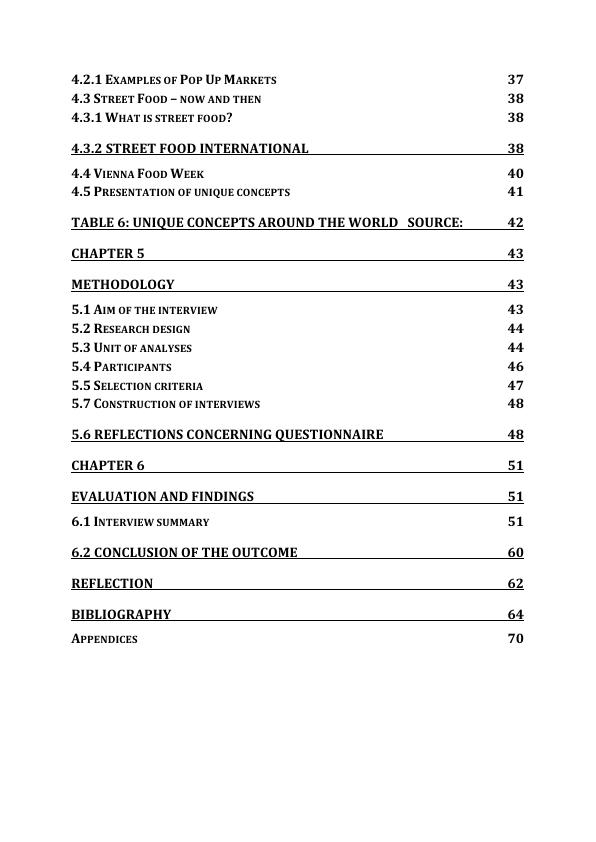
7
Chapter 1
Introduction
Motivation cognitive interests
Local culture is becoming more important due to the increase of competition
between tourism destinations. Gastronomy plays an intensely important role in
culture because not only food is significant to the tourist experience, but
moreover the fact, that gastronomy has become an important source of
identity evolution in postmodern cultures. (Greg Richards, “Gastronomy as a
source of regional identity and tourism development”, 2001).
Nowadays, we are confronted with food and culinary arts in every shape
continuously, but when did the first restaurant open its doors? Why and how
did gastronomy, as we now it today, evolve into a mass and capital oriented
industry?
I personally grew up in a gastronomically environment, being raised up in
between pots and pans I was always fascinated by this industry. An industry
that will always exist, because eating and drinking are basic needs that have to
be satisfied -‐ in which degree one is willing or interested in satisfying it, is the
other question. How and why are eating habits constantly changing, what are
the factors that influence them? Our population is constantly growing, but our
resources are limited – a challenge that has to be taken care of, awareness has
to be created.
Moreover, I want to find out where the trends are going, how and what people
eat, or what they expect in the future. Restaurants in Vienna open their doors
on a daily basis, but unfortunately also close faster than expected. To try to
overcome such slip-‐ups, it is very important to be aware of the historical and
Chapter 1
Introduction
Motivation cognitive interests
Local culture is becoming more important due to the increase of competition
between tourism destinations. Gastronomy plays an intensely important role in
culture because not only food is significant to the tourist experience, but
moreover the fact, that gastronomy has become an important source of
identity evolution in postmodern cultures. (Greg Richards, “Gastronomy as a
source of regional identity and tourism development”, 2001).
Nowadays, we are confronted with food and culinary arts in every shape
continuously, but when did the first restaurant open its doors? Why and how
did gastronomy, as we now it today, evolve into a mass and capital oriented
industry?
I personally grew up in a gastronomically environment, being raised up in
between pots and pans I was always fascinated by this industry. An industry
that will always exist, because eating and drinking are basic needs that have to
be satisfied -‐ in which degree one is willing or interested in satisfying it, is the
other question. How and why are eating habits constantly changing, what are
the factors that influence them? Our population is constantly growing, but our
resources are limited – a challenge that has to be taken care of, awareness has
to be created.
Moreover, I want to find out where the trends are going, how and what people
eat, or what they expect in the future. Restaurants in Vienna open their doors
on a daily basis, but unfortunately also close faster than expected. To try to
overcome such slip-‐ups, it is very important to be aware of the historical and
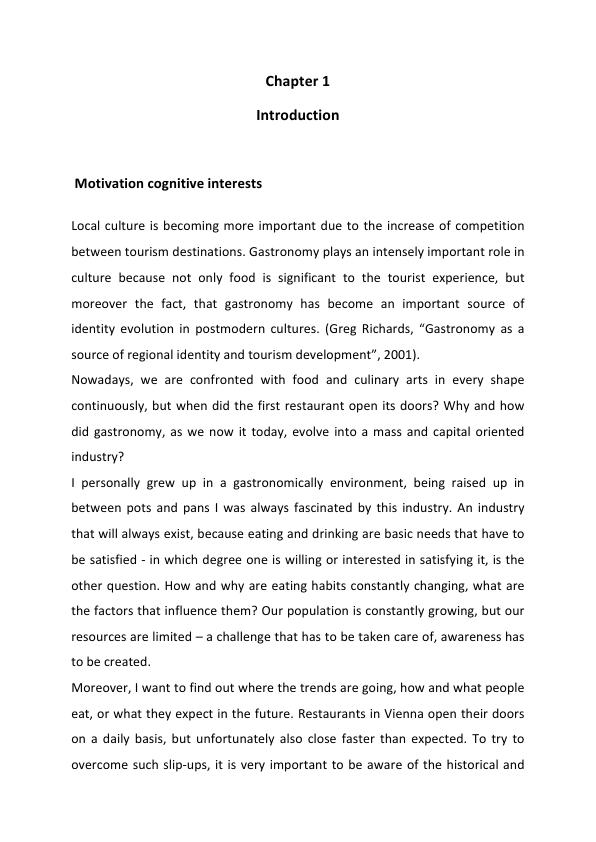
8
cultural background of gastronomy, as well as it ́s developments over time and
its future trends. With globalization and new media technologies, the
gastronomic industry has to adapt, in order to stay competitive. Everybody is
different. Everyone has different needs. And everybody has different
definitions of a good “restaurant”. By comparing these different aspects and by
talking to experts in this field, I will try to understand the market in order to
create awareness.
The saying, ‘we are what we eat’ is becoming increasingly important, not
necessarily in the physical sense, it has more to do with the cuisine we
purchase on holiday and with which we identify ourselves.
Not only the modern tourist is becoming more mobile, but also the food we
purchase.
Summarizing up what Richards said, the association of a specific food typ with
areas is being confronted thru culinary styles as well as the growing mobility of
food and the increasing differentiation of foods and cookeries.
A long way from creating a homogenized gastronomic scene, the strain in the
middle of globalization and confinement is delivering continually varieties. Not
only are global nourishments rising asfor example the world wide renowned
brand Coca Cola or the US fast food franchise concept McDonald's, however
regional food is flourishing, and “fusion foods” are being invented to nourish
the “global soul” (Greg Richards, “Gastronomy as a source of regional identity
and tourism development”, 2001)
Richards states that vacationers themselves are adding to gastronomic
versatility, by making an interest for substances they have experienced abroad,
or in their own nations. There are various scientific diagrams that show how
gastronomy has improved in taste and craftsmanship through time.
cultural background of gastronomy, as well as it ́s developments over time and
its future trends. With globalization and new media technologies, the
gastronomic industry has to adapt, in order to stay competitive. Everybody is
different. Everyone has different needs. And everybody has different
definitions of a good “restaurant”. By comparing these different aspects and by
talking to experts in this field, I will try to understand the market in order to
create awareness.
The saying, ‘we are what we eat’ is becoming increasingly important, not
necessarily in the physical sense, it has more to do with the cuisine we
purchase on holiday and with which we identify ourselves.
Not only the modern tourist is becoming more mobile, but also the food we
purchase.
Summarizing up what Richards said, the association of a specific food typ with
areas is being confronted thru culinary styles as well as the growing mobility of
food and the increasing differentiation of foods and cookeries.
A long way from creating a homogenized gastronomic scene, the strain in the
middle of globalization and confinement is delivering continually varieties. Not
only are global nourishments rising asfor example the world wide renowned
brand Coca Cola or the US fast food franchise concept McDonald's, however
regional food is flourishing, and “fusion foods” are being invented to nourish
the “global soul” (Greg Richards, “Gastronomy as a source of regional identity
and tourism development”, 2001)
Richards states that vacationers themselves are adding to gastronomic
versatility, by making an interest for substances they have experienced abroad,
or in their own nations. There are various scientific diagrams that show how
gastronomy has improved in taste and craftsmanship through time.
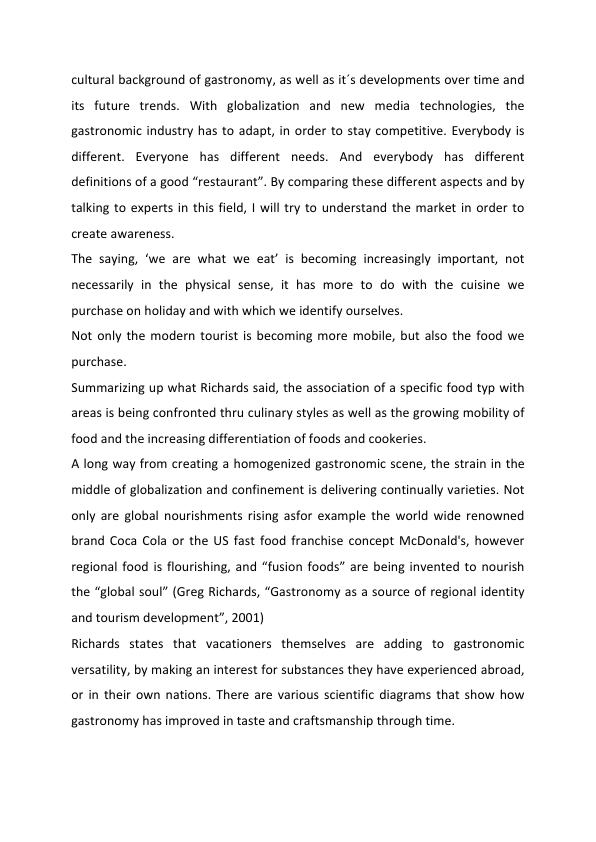
End of preview
Want to access all the pages? Upload your documents or become a member.